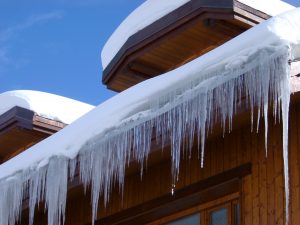23
Feb
Say No to Ice Dams and Frozen Pipes

| Reduce the Risk of Ice Dams Insulate and ventilate attic space: The underlying cause of ice dams is a warm roof, and the best way to address this is to hire a licensed contractor to inspect your attic space for proper insulation and ventilation. They should evaluate and ensure that: Attic space is properly ventilated to carry away warm air. Living space is well insulated and all points where warm air may leak up into the attic are sealed. |
| Clear snow: If your home has experienced ice damming in past seasons, enlist the help of a professional to rake excess snow off your roof and remove any existing ice dams after each heavy snowfall. |
| Evaluate roofing: If you are replacing your roof, ask your contractor to install an ice and water shield under the new roof cover. Consider a metal roof or, if you prefer shingled, have a drip edge installed to help with water runoff. |
Prevent Frozen & Burst Pipes Install a water shut-off device: This technology monitors your home’s water flow and automatically shuts off your main water valve when a suspected leak is detected. Many of our preferred vendors offer devices that allow you to monitor and control your water supply conveniently from your mobile phone. If your home has a smart thermostat, you can also use your mobile phone to monitor changes to your home’s interior temperature and, if it drops, turn off the water prior to a pipe burst. You may also qualify for a discount on your Homeowners premium for installing a water shut-off device. |
| Allow warm air to reach enclosed pipes: If you plan to be away from home, open cabinets under faucets, especially near exterior walls, to allow warm air from the living space to circulate in enclosed areas. While traveling, have a relative, neighbor or contractor periodically check your unoccupied home for leaks. |
| Keep consistent interior temperature: Maintain a consistent interior temperature of at least 65°F during the winter, especially when you are away from home. |
The material in this document is advisory in nature. No liability is assumed by reason of the information. It is offered as a resource to be used together with your professional advisors in maintaining a loss prevention program. PURE® Privilege Underwriters Reciprocal Exchange.

